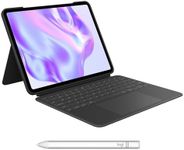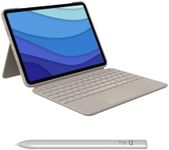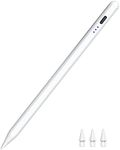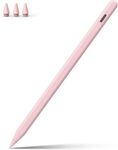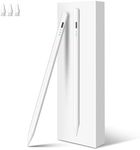Buying Guide for the Best Apple Pencils
Choosing the right Apple Pencil can make a big difference in your experience, whether you’re drawing, taking notes, or navigating your device. The key is to match the features of the stylus to how you plan to use it. Think about what tasks you’ll do most often, what device you have, and what feels comfortable in your hand. Understanding the main specifications will help you make a choice that fits your needs and ensures you get the most out of your iPad.CompatibilityCompatibility refers to which iPad models the Apple Pencil works with. This is crucial because not all Apple Pencils work with every iPad. Some are designed for specific generations or types of iPads, such as the standard, Air, mini, or Pro models. To navigate this, check which iPad you own and look for the Apple Pencil version that is officially supported for your device. Picking the right one ensures full functionality and avoids frustration.
Charging MethodThe charging method describes how the Apple Pencil is powered up. Some models charge via a Lightning connector, while others use magnetic wireless charging by attaching to the side of the iPad. The charging method affects convenience and how easily you can keep your Pencil ready to use. If you prefer a seamless experience, a wireless charging model might be best, but if you don’t mind plugging in, the Lightning version works well too. Consider your daily habits and how often you want to think about charging.
Pressure SensitivityPressure sensitivity is the Pencil’s ability to detect how hard you press on the screen, which is important for drawing and writing. Higher sensitivity allows for more natural and varied lines, making it feel more like using a real pen or brush. If you’re an artist or do a lot of handwriting, look for a Pencil with advanced pressure sensitivity. For basic navigation or simple note-taking, this feature may be less critical.
Tilt SupportTilt support means the Pencil can sense the angle at which you hold it, allowing for shading and more dynamic strokes, especially in drawing apps. This is important for artists who want to mimic traditional drawing techniques. If you plan to use your Pencil for creative work, tilt support is a valuable feature. For general use or basic notes, it’s less essential.
LatencyLatency is the delay between when you move the Pencil and when the mark appears on the screen. Lower latency means a more immediate and natural feel, which is especially important for drawing or fast note-taking. If you want a smooth, responsive experience, look for a Pencil with low latency. For occasional use, a slight delay may not be noticeable.
Ergonomics and GripErgonomics and grip refer to how comfortable the Pencil feels in your hand and how easy it is to hold for long periods. Some Pencils are round and smooth, while others have a flat edge or different textures. If you plan to use the Pencil for extended sessions, consider how it feels to hold and whether it suits your hand size and grip style. Comfort can make a big difference in your overall experience.
Additional FeaturesSome Apple Pencils offer extra features like double-tap gestures to switch tools or magnetic attachment for storage. These can add convenience and speed up your workflow. Think about whether these features would be useful for your tasks, such as quickly changing from pen to eraser or keeping your Pencil securely attached to your iPad.
